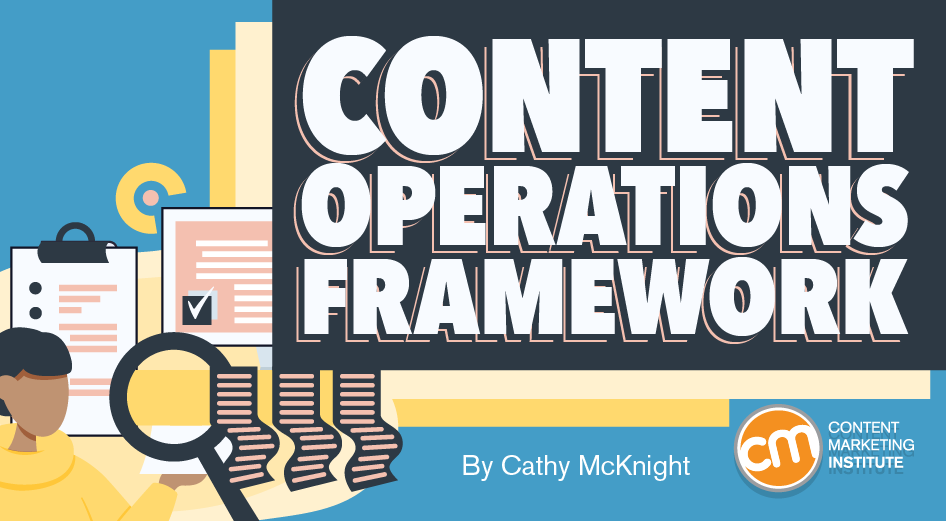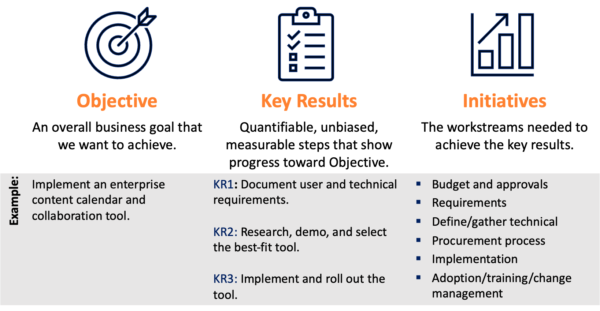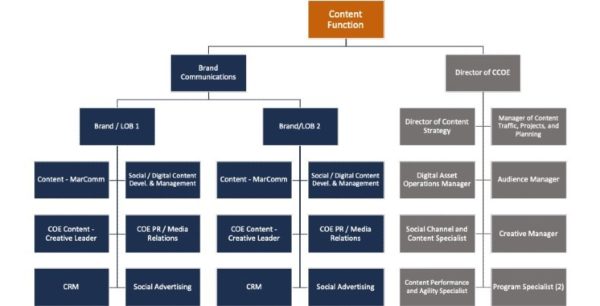MARKETING
Content Operations Framework: How To Build One

More and more marketers of all ilk – inbound, outbound, social, digital, content, brand – are asked to add content operations to their list of responsibilities.
You must get your arms around:
- Who is involved (and, I mean, every who) in content creation
- How content is created
- What content is created by whom
- Where content is conceived, created, and stored
- When and how long it takes for content to happen
- Why content is created (the driving forces behind content creation)
- What kinds of content does the audience want
- How to build a framework to bring order and structure to all of this
The evolving expectations mean content marketers can no longer focus only on the output of their efforts. They must now also consider, construct, implement, and administer the framework for content operations within their organizations.
#Content marketers can no longer focus solely on the output. It’s time to add content ops to the mix, says @CathyMcKnight via @CMIContent. Click To Tweet
What exactly are content operations?
Content operations are the big-picture view of everything content-related within your organization, from strategy to creation, governance to effectiveness measurement, and ideation to content management. All too frequently at the companies – large and small – we consult with at The Content Advisory, content operations are left to evolve/happen in an organic fashion.
Teams say formal content operations aren’t necessary because “things are working just fine.”
Translation: Nobody wants the task of getting everyone aligned. No one wants to deal with multiple teams’ rationale for why the way they do things is the right/best/only way to do it. So, content teams just go on saying everything is fine.
News flash – it’s not.
It’s not just about who does what when with content.
Done right, content operations enable efficacy and efficiency of processes, people, technologies, and cost. Content ops are essential for strategic planning, creation, management, and analysis for all content types across all channels (paid, earned, owned) and across the enterprise from ideation to archive.
A formal, documented, enforced content operation framework powers and empowers a brand’s ability to deliver the best possible customer experiences throughout the audiences’ journeys.
A documented, enforced #ContentOperations framework powers a brand’s ability to deliver the best possible experiences, says @CathyMcKnight via @CMIContent. Click To Tweet
It doesn’t have to be as daunting as it sounds.
What holds many content, administrative, and marketing teams back from embracing a formal content operations strategy and framework is one of the biggest, most challenging questions for anything new: “Where do we start?”
Here’s some help in high-level, easy-to-follow steps.
1. Articulate the purpose of content
Purpose is why the team does what it does. It’s the raison d’etre and inspiration for everything that follows. In terms of content, it drives all content efforts and should be the first question asked every time content is created or updated. Think of it as the guiding star for all content efforts.
In Start With Why, author Simon Sinek says it succinctly: “All organizations start with WHY, but only the great ones keep their WHY clear year after year.”
All organizations start with WHY, but only the great ones keep their WHY clear year after year, says @SimonSinek via @CathyMcKnight and @CMIContent. Click To Tweet
2. Define the content mission
Once the purpose of the teams’ content efforts is clear (and approved), it’s time to define your content mission. Is your content’s mission to attract recruits? Build brand advocacy? Deepen relationships with customers? Do you have buy-in from the organization, particularly the C-suite? This is not about identifying what assets will be created.
Can you talk about your mission with clarity? Have you created a unique voice or value proposition? Does it align with or directly support a higher, corporate-level objective and/or message? Hint: It should.
Answering all those questions solidifies your content mission.
ADVERTISEMENT
The marketer’s field manual to content operations
A hands-on primer for marketers to upgrade their content production process – by completing a self-audit and following our step-by-step best practices. Get the e-book.
3. Set and monitor a few core objectives and key results
Once your content mission is in place, it is time to set out how to determine success.
Content assets are called assets for a reason; they possess real value and contribute to the profitability of your business. Accordingly, you need to measure their efficacy. One of the best ways is to set OKRs – objectives and key results. OKRs are an effective goal-setting and leadership tool for communicating objectives and milestones to achieve them.
OKRs typically identify the objective – an overall business goal to achieve – and three to five key quantifiable, objective, measurable outcomes. Finally, establish checkpoints to ensure the ultimate objective is reached.
Let’s say you set an objective to implement an enterprise content calendar and collaboration tool. Key results to track might include:
- Documenting user and technical requirements
- Researching, demonstrating, and selecting a tool
- Implementing and rolling out the tool.
You would keep tabs on elements/initiatives, such as securing budget and approvals, defining requirements, working through procurement, and so on.

One more thing: Make sure OKRs are verifiable by defining the source and metric that will provide the quantifiable, measurable result.
Make sure objectives and key results are verifiable by defining source and metric, says @CathyMcKnight via @CMIContent. Click To Tweet
4. Organize your content operations team
With the OKRs set, you need people to get the work done. What does the structure look like? Who reports to whom?
Will you use a centralized command-and-control approach, a decentralized but-supported structure, or something in between? The team structure and organization must work within the construct and culture of the larger organization.
Here’s a sample organizational chart we at TCA developed for a Fortune 50 firm. At the top is the content function before it diverges into two paths – one for brand communications and one for a content center of excellence.
Under brand communications is each brand or line of business followed by these jointly connected teams: content – marcom, social/digital content development and management, center of excellence content – creative leader, center of excellence PR/media relations, customer relationship management, and social advertising.
Under the content center of excellence is the director of content strategy, manager of content traffic, projects, and planning, digital asset operations manager, audience manager, social channel and content specialist, creative manager, content performance and agility specialist, and program specialist.
5. Formalize a governance model
No matter how the operational framework is built, you need a governance model. Governance ensures your content operations follow agreed-upon goals, objectives, and standards.
Get a senior-management advocate – ideally someone from the C-suite – to preside over setting up your governance structure. That’s the only way to get recognition and budget.
To stay connected to the organization and its content needs, you should have an editorial advisory group – also called an editorial board, content committee, or keeper of the content keys. This group should include representatives from all the functional groups in the business that use the content as well as those intricately involved in delivering the content. The group should provide input and oversight and act as touchpoints to the rest of the organization.
Pointing to Simon Sinek again for wisdom here: “Passion alone can’t cut it. For passion to survive, it needs structure. A why without how has little probability of success.”
6. Create efficient processes and workflows
Adherence to the governance model requires a line of sight into all content processes.
How is content generated from start to finish? You may find 27 ways of doing it today. Ideally, your goal would be to have the majority (70% or more) of your content – infographic, advertisement, speech for the CEO, etc. – created the same or in a similar way.
You may need to do some leg work to understand how many ways content is created and published today, including:
- Who is involved (internal and external resources)
- How progress is tracked
- Who the doers and approvers are
- What happens to the content after it’s completed
Once documented, you can streamline and align these processes into a core workflow, with allowances for outlier and ad-hoc content needs and requests.
This example of a simple approval process for social content (developed for a global, multi-brand CPG company) includes three tiers. The first tier covers the process for a social content request. Tier two shows the process for producing and scheduling the content, and tier three shows the storage and success measurement for that content:
7. Deploy the best-fit technology stack
How many tools are you using? Many organizations grow through acquisitions, so they inherit duplicate or overlapping functionality within their content stacks. There might be two or three content management systems (CMS) and several marketing automation platforms.
Do a technology audit, eliminate redundancies, and simplify where possible. Use the inherent capabilities within the content stack to automate where you can. For example, if you run a campaign on the first Monday of every month, deploy technology to automate that process.
The technology to support your content operations framework doesn’t have to be fancy. An Excel spreadsheet is an acceptable starting place and can be one of your most important tools.
The goal is to simplify how content happens. What that looks like can vary greatly between organizations or even between teams within an organization.
Adopting a robust content operations framework requires cultural, technological, and organizational changes. It requires sponsorship from the very top of the organization and adherence to corporate goals at all levels of the organization.
None of it is easy – but the payoff is more than worth it.
Updated from a November 2021 post.
HANDPICKED RELATED CONTENT:
Cover image by Joseph Kalinowski/Content Marketing Institute





















You must be logged in to post a comment Login